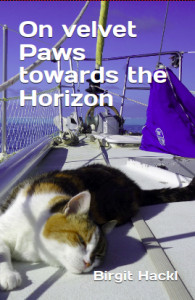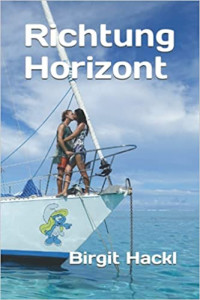Sunny skies and light winds, Pitufa is leisurly gliding towards the Caribbean.
2012
12
Feb
2012
09
Feb
Caribbean–we’re coming!
After a month in Suriname we’re now headed for the Caribbean. We’ll spend the next few months exploring Tobago, Grenada, the Venezuelan Antilles, the Dutch Antilles and maybe the coasts of Venezuela, Colombia, Panama etc. – we’ll just gather info, listen to other people’s experiences and will make up the itinerary on the way. Let’s see where the wind takes us!
2012
09
Feb
Photos of Suriname
We uploaded some pictures of our stay in Suriname. Even though we saw many animals like a giant anteater, otters and monkeys,
we can’t prove these encounters with photos, because the wildlife always turned up so unexpectedly that we never had a camera near. At least the pics show the forest and rivers where all these animals live. See for yourself:

Suriname
In January 2012 we caught a glimpse of Amazonia. Suriname provides an easy and save access to the rivers of the rainforest.
(38 photos)
2012
03
Feb
Wildlife
According to our initial plan we wanted to sail up the Perica and other rivers watching out for wildlife encounters. We pictured ourselves waiting motionless in the dinghy for hours to get a glimpse of some jungle creatures. Things turned out quite different: after a week we’re still anchored in the first spot we picked in the Perica, because the animals come round to our boat, usually when we’re doing some noisy work. They seem to be as interested in our behaviour, as we are in theirs. Read more »
2012
30
Jan
Up the rivers into the forest
We’ve had rainy weather for a week now, not as you’d expect during a tropical rainy season (torrential rain followed by sunshine), but a constant drizzle interrupted by downpours and some occasional sunny spells. The constant rain and humidity around 99 % are quite annoying, because we accumulate wet clothes that never have the chance to really dry out. Furthermore mould becomes a problem in cupboards and even on outer surfaces of our wooden furniture.
Despite the rain we anchored in Paramaribo last week, which is quite a hassle, because yachts are only allowed in a small section between the maritime authority and the presidential palace, where it gets rather crowded. On the one hand one is supposed to put out lots of chain because of the strong tides, on the other hand the yachts start drifting towards each other when the tide turns. Tidal currents of up to 4 knots make dinghy rides an additional adventure. Nevertheless we managed to do the laundry in a nearby hotel (first time since November…), bought some spare parts and provisioning and then set out to explore some rivers.
First we sailed a few miles up the Commewijne River, which is a confluent of the Suriname River and looks quite similar: a broad stream with murky water the colour of milk coffee. Then we turned off into the Cottica, which is still rather wide, but the water is already darker. There we spent the first night in a narrow river branch, next to the “last village” in the rainforest. We anchored right in the middle of the branch, let out only 20 m of chain (the depth was 10 m), as we had been told that the current wasn’t strong that far upriver. At 6 o’clock a splintering noise awoke us: the current had swept Pitufa into the dense branches reaching over the river. We freed her, ripping off some leaves and branches, but without any damage to the boat and set out for another creek further upstream: the Perica River, a black water creek. Navigation isn’t difficult here, as the Perica River is 10 – 18 m deep and between 20 and 50 m wide, but it’s important to look up when sailing, beca use some branches of the huge trees reach out far over the river. The scenery looks like on discovery channel: mangroves on the shores, a stunning diversity of trees and bushes with lianas dangling from the branches, huge butterflies and colourful birds fluttering everywhere. We anchored 3 miles up the river (this time with a stern line to a half-submerged tree to prevent another involuntary contact with the shore) and even though we’re just a few miles away from civilisation it’s a real jungle experience here. 100 m downstream lives a family of otters, happily splashing around, colibris are humming in the bush next to us and 5 minutes after I had a swim in the river this afternoon, a giant anteater decided to do the same–just 10 m away from the boat… We paddled our dinghy up the small Solitude Creek nearby to complete the jungle experience. The only downside are the swarms of mosquitos that bear down on us at dusk, but fortunately we can seal off Pitufa hermetically with mosquito nets.
2012
24
Jan
Liferaft as a bumper
Before moving to Paramaribo we decided to fill up our watertanks at a local fishing jetty, so we waited for high tide and then went alongside a fishing boat. Everything went fine until we wanted to set off again. The situation was a bit tricky, because of another boat right in front of us and the current which had already set in. We didn’t push off the bow enough, got caught in the current, steered hard right towards the open water, almost made it–but then we couldn’t avoid bumping with the stern against the last corner of the boat in front. BAMM.
Fortunately for Pitufa we had the liferaft tied to the pushpit and it took all the impact. Of course it’s quite squashed now, let’s see whether we can rescue it, otherwise we used it as a very expensive bumper…
It’s so depressing: we try to avoid spending money, don’t eat out often, watch every Euro in small things and then a few seconds cost a month of our cruising budget.
Anyway, nobody got hurt, Pitufa’s fine, just my self confidence looks similar to the squashed liferaft…
2012
22
Jan
Rainy Rainforest
After a week in Suriname we’ve managed to finish the clearance procedures and the most pressing repairs. Wayne Vaney the windvane is back on duty! Yesterday we made a trip to the interior and took a walk through the dense rainforest to a waterfall. Unfortunately it rained all day long, but the trees in the swirling clouds and the steaming ground was also quite atmospheric–no rainforest without rain ![]()
2012
20
Jan
Snapshots from the middle of the Atlantic Ocean
We’ve just uploaded a new mini gallery.

Crossing the Atlantic Ocean
On the 29th December, 2011, we set sail from the Cape Verdes to cross the Atlantic and arrived in Suriname 14 days later.
(10 photos)
2012
15
Jan
Atlantic crossing facts
Crossing the Atlantic ocean is typically the first really big passage for cruisers starting in Europe. It definitely was for us. Read more »
2012
14
Jan
Thanks!
We’ve just seen how many comments we got during our time on the Atlantic. Thanks to all of you who read, suffered and celebrated along with us!
2012
12
Jan
Arrived!
After 14 days and 1900 nautical miles we’ve dropped anchor in the Suriname river next to Domburg, had some champagne, and are looking forward to finally get some sleep ![]()
2012
10
Jan
Only 250 nm to go!
Soon we’ll have made it: only 250 of the 1900 nautic miles remain! After sailing a bit more slowly for 2 days (the northequatorial current had viciously abandoned us…) we now get a 2-knots turboboost from the northwest setting Guyana current. Thus we have an average speed of 7 knots (12,6 km/h) today – still more slowly than a bicycle, but sensational for our Pitufa ![]() . Today we’ve seen the first other ship in ten days, otherwise only dolphins (twice) and seabirds (astoundingly often) accompanied us.
. Today we’ve seen the first other ship in ten days, otherwise only dolphins (twice) and seabirds (astoundingly often) accompanied us.
2012
07
Jan
Two thirds covered
Pitufa’s flying along like never before (our fastest daily run this week was 160 NM) and so we’ve already covered two thirds of the way to Suriname! Yesterday a squall with torrential rain cleaned away the thick layers of Sahara sand we had gathered during our 3 months in the Cape Verdes. Today we’ve had clear skies all day long for the first time and the following waves, though higher now because we’ve left the north-equatorial current, look decidedly friendlier in blue. Leeloo spends hours in the cockpit watching those waves and whenever one roars particularly loud, Leeloo growls back.
2012
05
Jan
Half the distance done
Hurray! We have sailed already more than half the distance to Suriname. Last night our GPS displayed the magic number of 950nm left to go. Let’s hope we manage the second half just as fast. The winds are fine, the seas are low, and the north-equatorial current boosts us steadily. Though, we get a lot of rain now (which washes away the brown sand from the Cape Verdes eventually).
2012
03
Jan
Here comes the sun…
Today the weather has improved. Though, it started with thick clouds, drizzle and rain, the sun came out finally. So we’ve got blue sky with isolated clouds typical for the trade winds. This also means that the moon provides us with light at night. Standing at the helm is definitely more fun then. We are fine (given the circumstances) and make quick progress.




